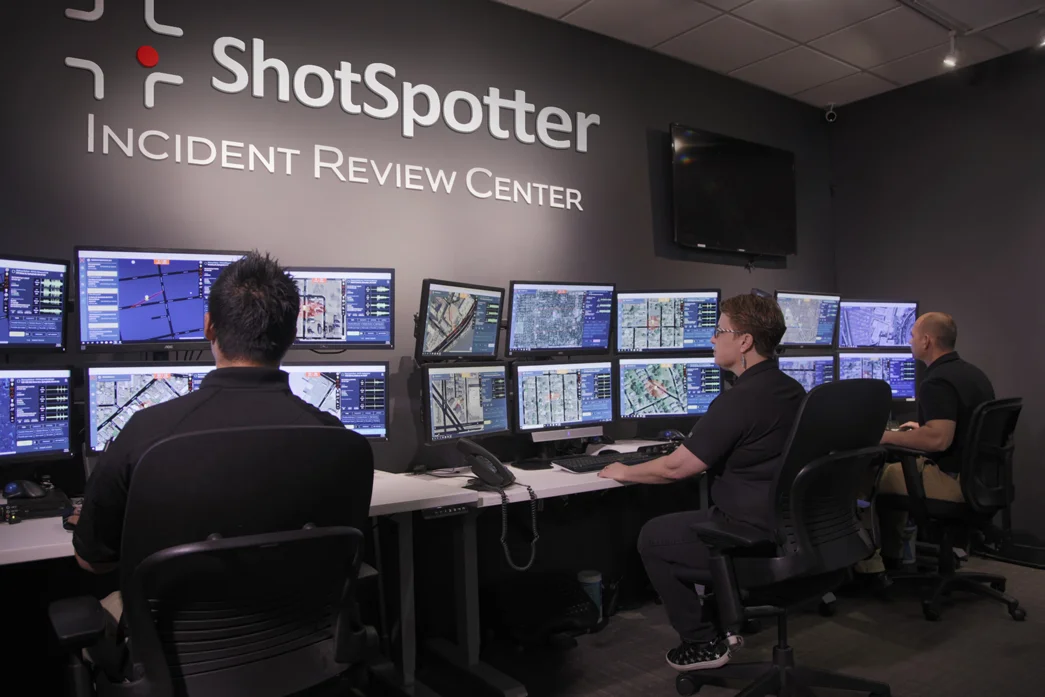With that said, there are a number of problematic comparisons and omitted or “cherry-picked” information referenced throughout the Journal of Urban Health study titled “Impact of ShotSpotter Technology on Firearm Homicides and Arrests Among Large Metropolitan Counties: A Longitudinal Analysis” regarding the impact of ShotSpotter technology that we feel compelled to address.
Evaluating Homicide Data Across Entire Counties
The study evaluated homicide data across entire counties in their assessment of the efficacy of ShotSpotter, when ShotSpotter coverage areas typically only cover a small part of counties. ShotSpotter does not detect and report incidents of gunfire outside of the coverage area where it is deployed. Therefore, ShotSpotter would not alert officers to instances of gunfire in the majority of the geographic areas that were used to measure ShotSpotter’s impact.
Take St. Louis, for instance. The study makes the claim that the implementation of gunshot detection technology in St. Louis, MO did not impact the level of reported gun crimes. But St. Louis County is 523 square miles. Of those 523 square miles, only 16.4 miles are in ShotSpotter’s coverage area. That’s only 3.1% of the entire county, so why is ShotSpotter’s impact being assessed for the entire county? Clearly, the more accurate assessment here would be to evaluate ShotSpotter’s impact specifically in that 16.4-mile coverage area, compared to comparable areas without it. But the study neglects to address that. This significant oversight leads us to believe that the Journal of Urban Health’s sweeping claims about ShotSpotter’s impact are baseless.
Opinions Based on Incomplete and/or “Cherry-Picked” Information
The Journal of Urban Health study’s critical evaluation of ShotSpotter’s impact in St. Louis also neglects to mention how the St. Louis study’s author, Dennis Mares, published an Op-Ed suggesting there was more to the story. Mares states: “My evaluation in St. Louis has been frequently cited in the media as evidence that ShotSpotter does not reduce crime, but my more recent work in Cincinnati shows strong crime reductions. Such mixed results suggest that the nature of the police response can be an important factor in success.”
It’s also worth noting that The Policing Project at the New York University School of Law conducted an independent review of ShotSpotter in neighboring St. Louis County and found that across the eight police precincts that were equipped with ShotSpotter: “reported assaults, which include gun-related assaults, declined by about 30 percent following the implementation of the technology relative to comparable areas without it.”
Focusing Only on Homicides and Arrests
The Journal of Urban Health study focused solely on ShotSpotter’s impact with regard to homicides and arrests. We would argue that this is an oversimplified approach as well as a limited barometer with which to assess the technology’s level of success.
For starters, there are many other metrics that the study could have taken into account, including total shootings, non-fatal shootings, victims saved, evidence recovered, and NIBIN leads, all of which provide a more complete picture of its impact.
Additionally, it’s important to remember that perpetrators do not typically remain at the scene of a gunfire incident awaiting police response, so evaluating the number of arrests made at a scene or suspects named in an initial police report is not an accurate way to measure effectiveness. Furthermore, less than 1 percent of the population is responsible for nearly two-thirds of shootings, so very few arrests can lead to significant reductions in gun violence.
Comparing ShotSpotter With Other Non-ShotSpotter Gunshot Detection Systems
The Journal of Urban Health study cites the ineffectiveness of a Philadelphia acoustic gunshot detection system as a means to support its arguments against ShotSpotter technology. But this Philadelphia study is a report evaluating another gunshot detection technology (a proximity-based single sensor) that experienced a high false positive rate. It did prove to be ineffective, and we do not dispute their findings—we only dispute the idea that it was any type of finding on ShotSpotter technology.
Parting Thoughts
SoundThinking respects the Journal of Urban Health and its mission to advance the health and well-being of people in cities. Furthermore, we respect the rigorous amount of analysis that goes into the journal’s research. With that said, it’s important to remind the world that ShotSpotter has a very powerful but very specific role to play in the complex puzzle that is nationwide firearm violence. We hope this article highlights our technology’s impact in doing what it was designed to do: notify law enforcement of all gunfire in a designated coverage area within 60 seconds, and enable fast and precise police response in the process.





